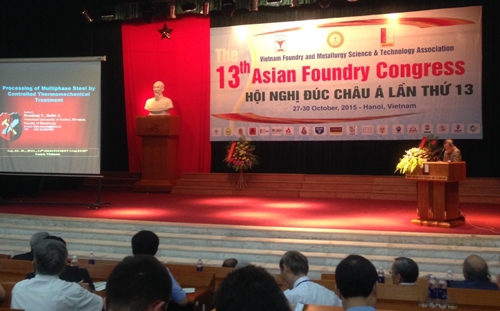-
-
-
Total payment:
-
 |
| 13th Asian Foundry Conference |
Plenty of advantages to developing the foundry industry
Speaking at the conference, Deputy Minister of Industry and Trade Cao Quoc Hung highly acknowledged the contribution of Vietnam's casting industry in general and the world's casting industry in particular in the mechanical engineering industry. Vietnam is gradually nearing its goal of industrialization and modernization, thus, the mechanical engineering business needs attention. In order to have a developed industry, it is vital to encourage the foundry industry, because this is an intermediate connecting the metallurgical industry and the mechanical engineering sector, thereby generating industrial products to give.
Mr. Pham Chi Cuong - Chairman of the Vietnam Association of Casting and Metallurgical Science and Technology - indicated that the casting sector can account for 40-70% of the value in the chain of manufacturing mechanical products. Vietnam's casting industry was put down in the 60s of the 20th century and along with the expansion of the iron and steel industry, during the restoration period, Vietnam's casting industry obtained certain outcomes in terms of quantity and quality.
Dr. Nguyen Huu Dung - Institute of Materials Science and Technology (Hanoi University of Science and Technology) - claimed that the globe is on the trend of integration and globalization. The foundry business like other industries must assert itself in the competitive conditions of the market economy. In fact, Asia is a location with a lot of advantages to developing the foundry business, due to the trend to relocate heavy manufacturing industries to developing countries with abundant and cheap labor. Therefore, for developing countries, including Vietnam, it is vital to take this as an opportunity and actively create technology, as a driving force to attract R&D investment from international firms. China, for example, leads the globe in this field, with production reaching 44 million tons in 2013.
Towards mastery of technology
Dr. Nguyen Huu Dung further evaluated, Vietnam's casting industry is in a situation of low level in both quantity and quality. Quantity is predicted to reach 2 million tons/year by 2020.
Professor of Science Nguyen Van Thai (Hanoi University of Science and Technology) also noted that there is a chance for Vietnam to develop to become a supplier of casting products for Southeast Asia. We have ample raw materials, abundant labor resources, and good conditions for the development of the foundry sector.
However, "for the development of casting industry, it is important to have a methodical investment, construct a system of centralized casting businesses or a vast region in the direction of high product specialization. At the same time, creating small enterprises as satellites to support large ones, focused on investing in equipment for the industry in a synchronized manner, "- Mr. Thai emphasized.
Currently, the casting business in particular and Vietnam's mechanical sector, in general, is merely machining, and has not yet mastered the technology because there is no design team. Therefore, it is required to develop a team of mechanics capable of designing and constructing equipment and casting lines.
| The casting industry will have many opportunities to absorb cutting-edge technologies, boost the rate of foreign investment, increase the rate of localization, and enhance the quality of casting details in the future when the State is determined to carry out important mechanical engineering programs. |
Nguyễn Duyên
Source: "http://baocongthuong.com.vn/nganh-duc-viet-nam-chu-dong-cong-nghe-de-nam-co-hoi.html"











